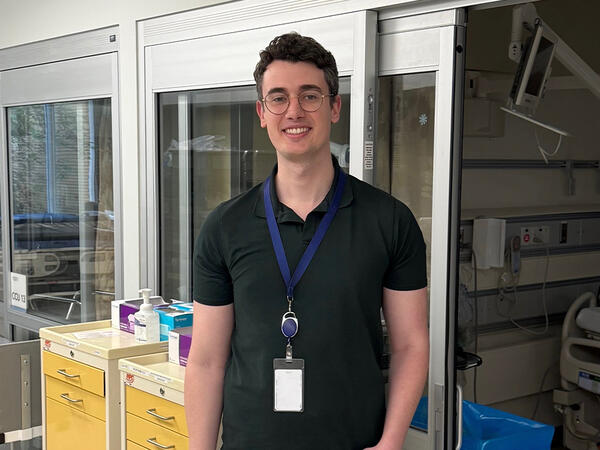Mina Tadrous led national group to develop guidance on how real-world evidence can be used in drug approvals and decision-making
New guidance on reporting real-world evidence (RWE) studies in regulatory and health technology assessment (HTA) submissions has been released, a move that may impact how some drugs are approved and evaluated in Canada.
Health Canada and CADTH, Canada’s drug and health technology agency, led the work and Mina Tadrous, assistant professor at U of T’s Leslie Dan Faculty of Pharmacy, co-chaired the working group that developed the guidance, which underwent a national public consultation last year.
“This guidance lays the foundation for the use of RWE in regulatory and HTA decision-making and will help develop a pathway to support the evaluation of newer drugs.”
“Using real-world evidence means we’re going to have better evidence where there are gaps, and we’re adapting to the changing landscape of how drugs are evaluated,” says Tadrous, an expert in real-world evidence and pharmaceutical policy. “This guidance lays the foundation for the use of RWE in regulatory and HTA decision-making and will help develop a pathway to support the evaluation of newer drugs.”
For many years, randomized controlled trials (RCTs) have provided robust evidence for drugs to be approved. They remain the gold standard of evidence, but still, there are some limitations. Some people, such as pregnant people or people with additional health conditions, might be excluded from clinical trials. Or, in the case of a highly targeted drug or a drug for a rare disease, finding enough participants to run a large trial may not be feasible.
In these cases, manufacturers can use real-world evidence, which includes data collected outside clinical trials, such as from patient health care records, patient registries, public and private insurance plans, and even wearable devices. Real-world evidence has long played an important role in evaluating safety, effectiveness and health economics after a drug has entered the market, but it will likely become increasingly important for drug approvals and value assessments.
“It’s becoming more challenging to rely only on RCTs in some scenarios, and this is limiting and slowing down our ability to get drugs to patients,” says Tadrous. “Real-world evidence will never and should never replace RCTs. But real-world evidence is a way to augment or add to a drug’s body of evidence that will support better decisions about what drugs are going to be approved and paid for.”
Canadian guidance will tackle drug approval and public funding
As drug approval agencies around the world have recognized that real-world evidence will become more important over the coming years with highly targeted drugs being developed, they saw a need to create standards to ensure that submissions to regulators were high quality and methodologically sound so decision-makers could use this evidence appropriately and with confidence.
This has been an issue globally, and the Food and Drug Administration in the United States and the European Union’s European Medicines Agency have already begun working toward using real-world evidence. For example, in 2021, the FDA approved a new immunosuppressant drug for people who received a lung transplant based on the results of a study using real-world evidence that showed benefit compared to how patients’ usually do after transplant without treatment.
“We haven’t had a big shift in how we approve drugs in a long time, and this is one of those game-changing moments.”
In 2022, CADTH approached Tadrous to help lead the development of a pan-Canadian guidance document that provided standards for using real-world evidence in drug approval and HTA submissions. The authorship team and a panel of national and international experts looked at similar guidelines produced by other countries and consulted with international experts to write guidance that would maximize transparency and work in a Canadian context.
Tadrous says that Canada is the first country to write guidance for real-world evidence reporting that is meant to be used for both drug approvals (regulatory) and health technology assessments that guide decisions on public reimbursement. This change is meant to help streamline the two processes and make it easier for new drugs to reach the market.
“The use of real-world evidence will be a change in how we approve and pay for drugs, and this guidance is the foundation of making that change happen by ensuring the highest-quality evidence is used,” says Tadrous. “We haven’t had a big shift in how we approve drugs in a long time, and this is one of those game-changing moments.”
Related information
More News
Image

Pharmacy alum’s research shows how full-scope practice improves cancer care
Honoured with a national award, Adrian de Boer says his residency experience was a powerful reminder that he's making a meaningful change to the pharmacy profession.
Read More
Image

Pharmacy alum passionate about helping community pharmacists practice to full scope
As a pharmacy leader at Rexall, Heidi Wittke uses frontline experience to lead initiatives that improve patient care
Read More
Image

Bridging Research and Industry: GRIP 2025 highlights innovation and real-world impact
Over 200 attendees from academia, healthcare, and industry gathered last week for the 2025 GRIP symposium, celebrating the depth and diversity of graduate student research.
Read More
